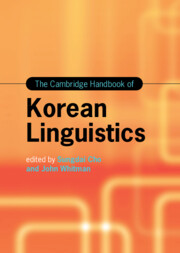Book contents
- The Cambridge Handbook of Korean Linguistics
- Cambridge Handbooks in Language and Linguistics
- The Cambridge Handbook of Korean Linguistics
- Copyright page
- Contents
- Figures
- Tables
- Contributors
- Preface
- Acknowledgments
- Abbreviations
- Part I Korean Overview
- Part II Phonetics and Phonology
- Chapter 7 Vowel Harmony
- Chapter 8 The Phonology and Phonetics of Korean Stop Laryngeal Contrasts
- Chapter 9 The Phonetics-Prosody Interface and Prosodic Strengthening in Korean
- Chapter 10 Constituent Structure and Sentence Phonology of Korean
- Chapter 11 Effects of Linguistic Experience on the Perception of Korean Stops
- Part III Morphology and Syntax
- Part IV Semantics and Pragmatics
- Part V Sociolinguistics and Psycholinguistics
- Part VI Language Pedagogy
- Index
- References
Chapter 8 - The Phonology and Phonetics of Korean Stop Laryngeal Contrasts
from Part II - Phonetics and Phonology
Published online by Cambridge University Press: 30 September 2022
- The Cambridge Handbook of Korean Linguistics
- Cambridge Handbooks in Language and Linguistics
- The Cambridge Handbook of Korean Linguistics
- Copyright page
- Contents
- Figures
- Tables
- Contributors
- Preface
- Acknowledgments
- Abbreviations
- Part I Korean Overview
- Part II Phonetics and Phonology
- Chapter 7 Vowel Harmony
- Chapter 8 The Phonology and Phonetics of Korean Stop Laryngeal Contrasts
- Chapter 9 The Phonetics-Prosody Interface and Prosodic Strengthening in Korean
- Chapter 10 Constituent Structure and Sentence Phonology of Korean
- Chapter 11 Effects of Linguistic Experience on the Perception of Korean Stops
- Part III Morphology and Syntax
- Part IV Semantics and Pragmatics
- Part V Sociolinguistics and Psycholinguistics
- Part VI Language Pedagogy
- Index
- References
Summary
Chapter 8 examines the typologically rare three-way laryngeal contrast found in Korean. As also noted in Chapter 2, the manner contrasts in the Korean obstruent inventory have been the point of departure for many descriptive and theoretical contributions to the typology of laryngeal contrasts and related issues, such as feature theory. More recently, a diachronic change characterized by the redistribution of cue weights from the consonantal to the vocalic portion of the signal, mirroring the common historical process of tonogenesis, has sparked renewed interest in the Korean laryngeal contrasts. The opportunity to observe such a change in vivo, and to compare its progression across different dialects, provides an ideal testing ground for theories of sound change. This chapter provides a review of the literature on the phonetic and phonological characterizations of the stop-laryngeal contrast, as well as a survey of dialectal and diachronic variation in its phonetic realization. The chapter closes with an apparent-time study documenting dialectal variation and change in the use of three acoustic cues to the contrast (VOT, f0, and H1-H2) in three dialects of Korean.
- Type
- Chapter
- Information
- The Cambridge Handbook of Korean Linguistics , pp. 215 - 247Publisher: Cambridge University PressPrint publication year: 2022
References
- 1
- Cited by

